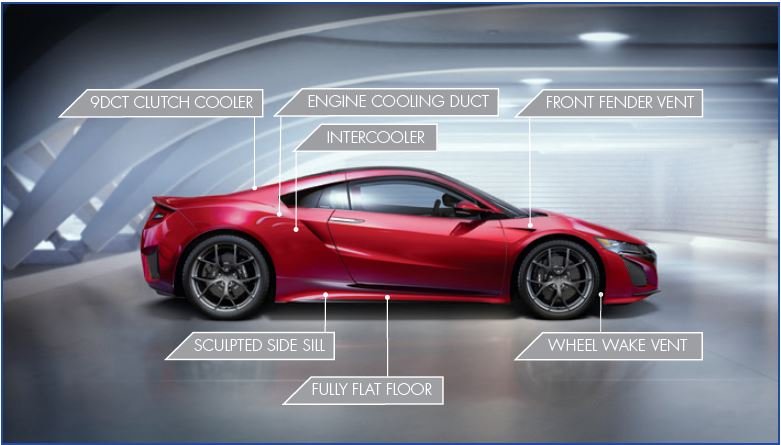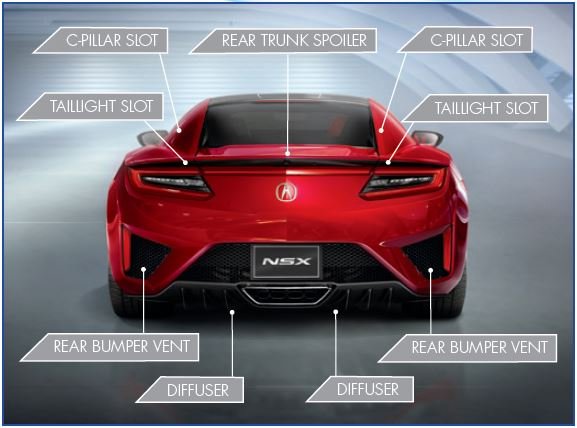A supercar needs to be visually spectacular, no question. But a supercar’s body is more than just sculpture. It’s sculpture that moves really fast!
Control, Cooling and Combustion
Air performs several critical functions for the NSX:
› Aerodynamic performance is critical to reduce drag,
create downforce and balance the car’s handling
across the entire speed range.
› A supercar is an incredibly dense assemblage of
components and a lot of them are wicked hot,
requiring continuous cooling airflow.
› The engine itself needs to breathe to convert
premium unleaded into life-changing memories.
Hot Spots
There are seven different heat sources in the hybrid-based powertrain that make the NSX go:
› 3.5-liter V-6 Engine
› Twin Turbochargers
› 9-speed Transmission
› Dual Clutch System
› Power Distribution Unit
› Twin Motor Unit
“Too Cool!”
Cooling air is directed at the parts that make NSX go and the parts that make it stop:
› To provide efficient cooling, airflow is managed
through 10 different heat exchangers.
› To make the NSX stop, four massive disc brakes
convert kinetic energy into intense heat,
so each disc and caliper needs cooling, too.
Form with a Function
Scoops, Slots and Curves
During the development of the NSX, the engineering team worked to take full advantage of virtually every molecule of air passing, not only over the body, but also through the body. They attacked the aerodynamic performance from every angle with computer simulations and wind-tunnel testing. Every scoop, slot and curve of the NSX body is there for a reason.
Every scoop, slot and curve of the NSX body is there for a reason.
Imagine for a moment you’re a stationary molecule of air, just hanging out, being air. An NSX appears on the horizon, bearing down on you at high speed. Uh-oh. This is going to be a wild ride!
› When the NSX arrives (swiftly) you might flow
through the large front intakes, feeding three large
radiators that provide cooling to the advanced power
unit. Now much hotter than you were milliseconds
ago, you exit the car’s body through hood vents—
providing critical front downforce.
› Or you might enter through wheel wake vents and
be directed to the broiling-hot front brakes—and
then get sucked out of the fender vent, which
creates a jet stream and pushes you against the
door and along the body. (This is important,
because the NSX is not through with you.)
› From there, you might dive into the large side air
intakes underneath the floating C-pillar to feed the
engine intake, cool the intercoolers and further cool
the power unit.
› Or you might exit through the C-pillar onto the rear
deck lid, providing rear downforce. A combination of
the rear deck spoiler, the rear diffuser and the small
taillight vent work in unison to keep you in line.
And suddenly, it’s over. The NSX is gone, but you’ll be telling your molecule buddies about the experience for years to come.
American Honda created the video below to demonstrate the air flow in action



